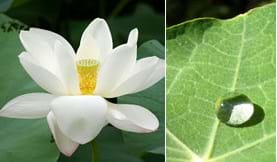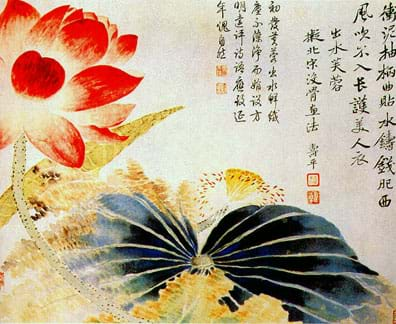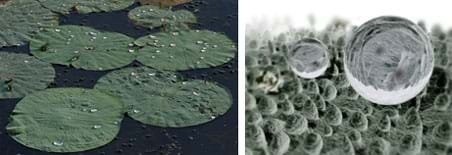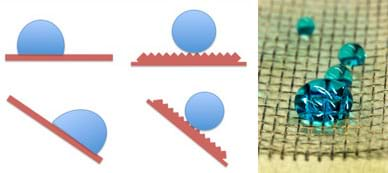Quick Look
Grade Level: 12 (10-12)
Time Required: 30 minutes
Lesson Dependency:
Subject Areas: Biology, Chemistry, Life Science, Physical Science, Physics
NGSS Performance Expectations:

| HS-PS2-6 |

Summary
Students are introduced to superhydrophobic surfaces and the "lotus effect." Water spilled on a superhydrophobic surface does not wet the surface, but simply rolls off. Additionally, as water moves across the superhydrophobic surface, it picks up and carries away any foreign material, such as dust or dirt. Students learn how plants create and use superhydrophobic surfaces in nature and how engineers have created human-made products that mimic the properties of these natural surfaces. They also learn about the tendency of all superhydrophobic surfaces to develop water droplets that do not roll off the surface but become "pinned" under certain conditions, such as water droplets formed from condensation. They see how the introduction of mechanical energy can "unpin" these water droplets and restore the desirable properties of the superhydrophobic surface.Engineering Connection
Inspired by nature, the self-cleaning superhydrophobic products being engineered today are destined to become important and novel products in our everyday lives. Some products include: coatings that reduce the water drag on boats and protect surfaces and equipment exposed to fresh or salt water, building materials that remain clean with little maintenance and are better protected from wear from the elements, and textiles that are resistant to staining and/or remain dry when submerged in water.
Learning Objectives
After this lesson, students should be able to:
- Describe situations in which a superhydrophobic lotus-effect surface would be useful.
- Explain the difference between Cassie-Baxter and Wenzel wetting and how it applies to superhydrophobic surfaces.
- Demonstrate the transition between Wenzel and Cassie-Baxter wetting states.
Educational Standards
Each TeachEngineering lesson or activity is correlated to one or more K-12 science,
technology, engineering or math (STEM) educational standards.
All 100,000+ K-12 STEM standards covered in TeachEngineering are collected, maintained and packaged by the Achievement Standards Network (ASN),
a project of D2L (www.achievementstandards.org).
In the ASN, standards are hierarchically structured: first by source; e.g., by state; within source by type; e.g., science or mathematics;
within type by subtype, then by grade, etc.
Each TeachEngineering lesson or activity is correlated to one or more K-12 science, technology, engineering or math (STEM) educational standards.
All 100,000+ K-12 STEM standards covered in TeachEngineering are collected, maintained and packaged by the Achievement Standards Network (ASN), a project of D2L (www.achievementstandards.org).
In the ASN, standards are hierarchically structured: first by source; e.g., by state; within source by type; e.g., science or mathematics; within type by subtype, then by grade, etc.
NGSS: Next Generation Science Standards - Science
| NGSS Performance Expectation | ||
|---|---|---|
|
HS-PS2-6. Communicate scientific and technical information about why the molecular-level structure is important in the functioning of designed materials. (Grades 9 - 12) Do you agree with this alignment? |
||
| Click to view other curriculum aligned to this Performance Expectation | ||
| This lesson focuses on the following Three Dimensional Learning aspects of NGSS: | ||
| Science & Engineering Practices | Disciplinary Core Ideas | Crosscutting Concepts |
| Communicate scientific information (e.g., about phenomena and/or the process of development and the design and performance of a proposed process or system) in multiple formats (including orally, graphically, textually, and mathematically). Alignment agreement: | Attraction and repulsion between electric charges at the atomic scale explain the structure, properties, and transformations of matter, as well as the contact forces between material objects. Alignment agreement: | Investigating or designing new systems or structures requires a detailed examination of the properties of different materials, the structures of different components, and connections of components to reveal its function and/or solve a problem. Alignment agreement: |
International Technology and Engineering Educators Association - Technology
-
Students will develop an understanding of the relationships among technologies and the connections between technology and other fields of study.
(Grades
K -
12)
More Details
Do you agree with this alignment?
-
Chemical technologies provide a means for humans to alter or modify materials and to produce chemical products.
(Grades
9 -
12)
More Details
Do you agree with this alignment?
State Standards
North Carolina - Science
-
Understand types, properties, and structure of matter.
(Grades
9 -
12)
More Details
Do you agree with this alignment?
Introduction/Motivation
(In advance, prepare the capability to:
- Show students a 24-second video of water on a lotus leaf
- Show students the Figure 1 photos, either by projector or a printout to pass around
- Conduct a demonstration using a lotus leaf*, water, mud, sand, water container, and fish tank
- Show the class a few Internet videos using a computer and projector
*Note about the lotus leaf: In addition to lotus leaves, the leaves of the following plants also demonstrate superhydrophobicity: broccoli, Brussels sprout, cabbage, collard greens, kale, taro (elephant's ear), tulip, turnip greens and water lily. All leaves should be fresh, or have been kept refrigerated in a plastic bag since being cut. Alternately, purchase dried lotus leaves from an Asian grocery. Keep in mind that the oils from your hands will eventually destroy the effect. Wear lab gloves if you plan to use the same leaf for multiple classes.)
(Begin the lesson by showing students the 24-second "Water on Lotus Leaf" video, and leading a brainstorming session, as described in the Assessment section.)
(Show the class the photographs in Figure 1. While they are being projected or passed around, ask students questions about concepts learned in previous surface tension lessons.)
Looking at these photographs, do you think dry dirt would stick as well to the clothing and car as the mud does? Why do you think the mud sticks better? What do you think we can change to make the mud less likely to stick? (Let students think about their answers and make their best educated guesses.)
(Take any everyday object and place it into a container of water and then pull it out. Make the point to students that the object is "wet" — point out the water drops on it.) Why does the water stick?
(Take a lotus leaf [or other leaf] and ask a student to touch along the edge of the lotus leaf.) How does it feel? (The lotus leaf feels smooth; description will vary with other plants).
What will happen when I pour water onto this leaf? (Tilt the leaf towards the class. Pour water onto the leaf and allow it to run into a container.) What is happening to the water? (The water forms beads and runs off the surface without appearing to stick to the leaf at all. You may want to introduce the ideas of water-repellant surfaces and surface structure of the lotus leaf.)
(Immerse a lotus leaf into a fish tank of water. The surface of the plant appears silvery). What causes the silver color while the lotus leaf is under water? (Air trapped by the surface structure. The water is not being allowed to touch the leaf directly.)
What will happen when I pull it out of the water? (When you pull the leaf out it should be perfectly dry. If possible, have a few students come up and try it for themselves.)
(Sprinkle dirt or sand onto the lotus leaf.) What do you think will happen if I pour water on top of the dirt? Will the mud/wet sand stick to the leaf? (Listen to student predictions.)
(Dribble water onto the leaf and tilt the leaf so that that a few water droplets travel across it.) What is happening to the dirt? (The water has picked up the dirt and left the leaf itself clean.) What is happening to the water and the leaf? Lotus leaves, and other surfaces in nature, are what we call superhydrophobic. (Proceed to share with students additional information on superhydrophobic surfaces, including condensation and the Wenzel and Cassie Baxter wetting states, as found in the Lesson Background section, as is suitable for your students and time constraints.)
Why would this property be important for the lotus plant in nature?
How may this property relate to keeping clothes and other materials clean?
(Show students the following videos, which demonstrate examples of how clothing, cars and housing surfaces can remain clean by applying a superhydrophobic coating.)
- Demonstration of NanoTex stain repellant clothing (3:49 minutes); filmed by Today Show; posted by user gotnano at: https://www.youtube.com/watch?v=o7enQj6Z9pM
- Demonstration of Stolit Lotusan self-cleaning finish to protect buildings (2:02 minutes); filmed and posted by Sto Corp at https://www.youtube.com/watch?v=LpV9FN-ymQQ
- Demonstration of NanoBionics automobile treatment to repel mud, grime, and water from exterior finish (1:56 minutes); filmed and posted by Nanotec-USA at: https://www.youtube.com/watch?v=JGXqxvd9jFI&NR=1&feature=fvwp
Today, we will study superhydrophobic surfaces and their applications and limitations.
Lesson Background and Concepts for Teachers
Superhydrophobic Surfaces

In some Asian religions, the lotus plant is revered as a symbol of purity. The roots of the lotus plant take hold in the muddy bottoms of ponds and riverbeds. From there, thick stems rise above the water's surface and issue giant, pristine leaves and flowers. The leaves remain clean despite the water and mud on which they rest. Even water refuses to stick to the leaves of the lotus plant. Instead, it beads on the surface and rolls off at the slightest disturbance (see Figure 2). 
Scientists have found that the basis for both of these properties (self-cleaning and water-repellent) lies in the rough structure of the surface of the lotus leaves. The lotus leaf has a series of protrusions on the order of 10 μm (1.0 x 10- 5 m) high covering its surface. Each protrusion is itself covered in bumps of a hydrophobic, waxy material that are roughly 100 nm (1 x 10-7 m) in height. When water droplets are applied to the lotus leaf, they sit lightly on the tips of the hydrophobic protrusions as if on a bed of nails (see Figure 2). This combined structure traps a layer of air in between the surface of the leaf and the water droplet. Hence, the water is not allowed to wet the surface and is easily displaced (see Figure 3).
The surface of a lotus leaf is an example of superhydrophobicity. On a superhydrophobic surface, the contact angle is greater than 150o, meaning almost no wetting of the surface by the liquid takes place. This leads to the second property associated with lotus plants — the ability to stay spotlessly clean. As rain falls on a superhydrophobic surface like the lotus leaf, the water droplets roll easily off the leaf surfaces (see Figure 3). As the droplets travel along the leaves, they pick up any dirt or other matter they encounter along the way. This process keeps the lotus leaves dry, clean and free of pathogens such as bacteria and fungi.
The self-cleaning and water-repellent qualities of superhydrophobic surfaces have the potential for many practical applications. Refer to the associated activity Exploring the Lotus Effect for students to explore and compare the superhydrophobic water-repellent and "self-cleaning" properties of the lotus leaf and cloth with a synthetic superhydrophobic coating. House paints, roof tiles and various surface coatings are already on the market (see Figure 3). These products are examples of "biomimicry." By understanding how the lotus leaf and other plants create superhydrophobic surfaces by using a two-tiered surface layer, engineers have created human-made surfaces that "mimic" the properties of the natural ones. One of the most interesting uses of human-made superhydrophobic surfaces are fabrics made by Nano-Tex™ and other manufacturers that repel tomato sauce, coffee and even red wine. Researchers are also developing fabrics that can stay dry for days underwater, swimsuits that cannot become wet, and ship hulls with dramatically reduced drag.
Condensation and Sperhydrophobic Surfaces
In nature, when dew condenses on lotus leaves, the dew soon rolls off the leaf, just as water droplets falling onto the leaf do. However, when scientists began to study the superhydrophobic properties of the lotus leaf, they discovered water behaved differently in laboratories. Water poured or dropped on leaves in a controlled setting still demonstrated superhydrophobic properties. However, when water vapor was allowed to condense onto a lotus leaf in the lab, the water droplets were "sticky" and clung to the leaves.
When water vapor condenses on a rough surface, it forms from inside the texture of the surface. As this water droplet grows it enters the "sticky" Wenzel wetting state in which the droplet is "pinned" to the surface (see Figure 4). These droplets do not display the easy motion of droplets on a superhydrophobic surface. In the lab, droplets remain in this "sticky" state, but in nature water vapor condensation, such as dew, soon transitions into a second wetting state known as the Cassie-Baxter wetting state. 
When water is dropped or poured onto superhydrophobic surfaces, the water droplets sit lightly on the very tips of the surface protrusions, leaving a layer of air between the droplets and the leaf surface. Water droplets in this Cassie-Baxter state demonstrate the extreme water repellency that characterize superhydrophobicity (see Figure 5).
The transition between the Wenzel and Cassie-Baxter states requires an input of energy. In nature, this energy might be provided by the mechanical energy supplied by wind or water movement. When dew forms on a lotus leaf in the "sticky" Wenzel state, the movement of the leaf provides enough energy to "unpin" the water droplet and allow it free movement to roll off the leaf. In a laboratory setting, this mechanical energy must be provided by the experimenter, such as placing the lotus leaf on a stereo speaker or shaking the lotus leaf by hand.
Associated Activities
- Exploring the Lotus Effect - Students explore and compare the superhydrophobic water-repellent and "self-cleaning" properties of the lotus leaf and cloth with a synthetic superhydrophobic coating. They observe the Wenzel and Cassie Baxter wetting states with condensation droplets on leaf surfaces. They consider the real-life engineering applications for these amazing properties.
Assessment
Pre-Lesson Assessment
Opening Biomimicry Brainstorm: Show students the 24-second "Water on Lotus Leaf" video by Stratege2002, available at https://www.youtube.com/watch?v=MFHcSrNRU5E. Afterwards, ask students, either individually or in small groups, to brainstorm to develop possible explanations for the phenomena. Require students to also propose how such an effect might be useful if you could mimic it. As a class, have students share their ideas and decide on a few of the best ideas.
Post-Introduction Assessment
Contrast Wenzel and Cassie-Baxter States: On a large note cards or pieces of paper, have students write the differences between the Wenzel and Cassie-Baxter wetting states. Draw a line down the center of the paper, write Wenzel on one side and Cassie-Baxter on the other, and then list the differences between the two states, side by side. Do this either individually, in small groups, or as a class using an overhead projector.
Lesson Summary Assessment
Three-Minute Writing: Hand each student a note card. Instruct them to write down — in three minutes — everything they learned in today's lesson. It doesn't matter if the information is out of order. Small diagrams or drawings are fine. Encourage students to try to fill the note card front and back in the time given. Require that they do this from memory — they may not refer to their notes.
Homework
Reading a Scientific Article: Either from a hard copy or online, have students read the Scientific American article, Self-Cleaning Materials: Lotus Leaf-Inspired Nanotechnology by Peter Forbes. Then have students answer the following questions:
- What are the causes and effects of superhydrophobicity (the lotus effect)?
- How might the lotus effect be used in consumer products?
- What is superwettability? What are its causes and effects?
- How might superwettability be used in consumer products?
- What did Andrew R. Parker find interesting about the Stenocara beetle? How is his design to imitate the beetle being used?
Subscribe
Get the inside scoop on all things TeachEngineering such as new site features, curriculum updates, video releases, and more by signing up for our newsletter!More Curriculum Like This

Students test and observe the "self-cleaning" lotus effect using a lotus leaf and cloth treated with a synthetic lotus-like superhydrophobic coating. They also observe the Wenzel and Cassie Baxter wetting states by creating and manipulating condensation droplets on the leaf surface.

Through hands-on activities, students learn how the combination of adhesive forces and cohesive forces cause capillary motion. They study different effects of capillary motion and use capillary motion to measure surface tension. Students explore the phenomena of wetting and hydrophobic and hydrophil...

Students are presented with the concepts of wetting and contact angle. They are also introduced to the distinction between hydrophobic and hydrophilic surfaces. Students observe how different surfaces are used to maintain visibility under different conditions.

Students are presented with the question: "Why does a liquid jet break up into droplets?" and introduced to its importance in inkjet printers. A discussion of cohesive forces and surface tension is included, as well as surface acting agents (surfactants) and their ability to weaken the surface tensi...
References
Boreyko, Jonathan B. and Chuan-Hua Chen. Published October 21, 2009. "Restoring Superhydrophobicity of Lotus Leaves with Vibration-Induced Dewetting." Physical Review Letters, Vol. 103, No. 17. Accessed July 2010. (abstract) http://prl.aps.org/abstract/PRL/v103/i17/e174502
de Gennes, Pierre-Gilles, et al. Capillarity and Wetting Phenomena: Drops, Bubbles, Pearls, Waves, Waves. New York, NY: Springer, 2004.
Forbes, Peter. "Self-Cleaning Materials: Lotus Leaf-Inspired Nanotechnology." Published July 30, 2008. Scientific American. Accessed July 2010. https://www.scientificamerican.com/article/self-cleaning-materials/
"Nature's Raincoats." Last updated 2009. The Royal Society: Summer Science Exhibition. Accessed September 1, 2010. http://www.naturesraincoats.com/
Zenner, Greta M., et al. "Lotus Leaf Effect." University of Wisconsin-Madison Materials Research, Science and Engineering Center (MRSEC) Interdisciplinary Education Group, Nanoscale Informal Science Education Network. Accessed July 2010. http://mrsec.wisc.edu/Edetc/EExpo/surfaces/NanoSurfaces_ProgramGuide.pdf
Copyright
© 2013 by Regents of the University of Colorado; original © 2011 Duke UniversityContributors
Jean Stave, Durham Public Schools, NC; Chuan-Hua Chen, Mechanical Engineering and Material Science, Pratt School of Engineering, Duke UniversitySupporting Program
NSF CAREER Award and RET Program, Mechanical Engineering and Material Science, Pratt School of Engineering, Duke UniversityAcknowledgements
This digital library content was developed under an NSF CAREER Award (CBET- 08-46705) and an RET supplement (CBET-10-09869). However, these contents do not necessarily represent the policies of the National Science Foundation, and you should not assume endorsement by the federal government.
Special acknowledgements to Jonathan Boreyko, Mechanical Engineering and Material Science, Pratt School of Engineering, Duke University.
Last modified: March 14, 2021









User Comments & Tips